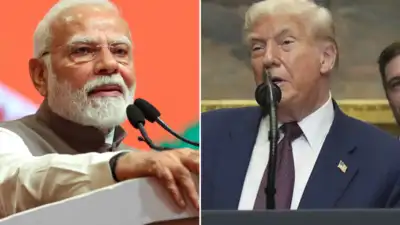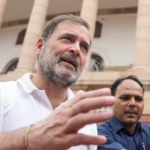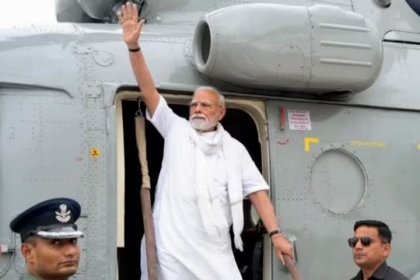India Dismisses Trump’s Penalty Threat, Calls Russia Ties ‘Time-Tested’ Amid Energy Import Row
In a world where energy diplomacy often drives global alliances and fractures others, India has taken a confident and calculated stance. Brushing aside warnings from former U.S. President Donald Trump—who suggested punitive measures for countries continuing energy deals with Russia—India has reiterated its position with remarkable clarity. Its message is simple but profound: India’s relationship with Russia is “time-tested” and not subject to fluctuating geopolitical pressures.
This decision by the Indian government is not a spur-of-the-moment declaration but the latest move in a carefully crafted foreign policy strategy—one that seeks to balance energy security, long-term alliances, and national interests against rapidly shifting global currents.
🛢️ Energy at the Center of Diplomacy
Energy has long been at the core of international relations. For a rapidly developing country like India, with a population of over 1.4 billion and an expanding industrial base, a reliable energy supply is not just a matter of economic policy—it is a national imperative.
In recent years, Russia has become a major supplier of crude oil to India, often offering discounts amid sanctions by Western nations. These purchases, while economically sound for India, have drawn sharp criticism—particularly from sections of the U.S. administration that view continued trade with Russia as undercutting Western pressure in the wake of global conflicts.
🗣️ Trump’s Warning and India’s Response
Donald Trump’s statement, delivered during a campaign event in mid-2025, warned of “economic consequences” for nations that “continue to empower regimes that threaten global peace.” While he did not name India directly, the subtext was evident. His remarks sparked discussions in diplomatic and media circles, with speculation about whether India would recalibrate its import strategy.
However, the Indian government was quick to issue a pointed yet composed response. In a press briefing, the Ministry of External Affairs emphasized that India’s strategic autonomy would not be compromised and that its ties with Russia are rooted in decades of trust, defense cooperation, and mutual respect.
“Our ties with Russia are time-tested. We pursue an independent foreign policy and act in the best interests of our energy security and national priorities,” said a senior MEA spokesperson.
🏛️ The Strategic Legacy of Indo-Russian Relations
India and Russia (formerly the Soviet Union) share a relationship that dates back to the Cold War era. The ties are multifaceted—covering defense, nuclear cooperation, space research, trade, and cultural exchange. During times of crisis, Moscow has often stood by India, including vetoing anti-India resolutions at the United Nations.
Despite the emergence of a multipolar world and India’s growing ties with the United States, its relationship with Russia has remained robust. In fact, India has managed to walk a diplomatic tightrope—engaging deeply with the U.S. through the Quad and defense deals, while simultaneously retaining its deep-rooted defense and energy cooperation with Moscow.
🔍 Beyond Geopolitics: The Economics of Energy Imports
From a purely economic standpoint, India’s continued purchase of Russian crude oil makes fiscal sense. With global oil prices fluctuating and OPEC+ decisions impacting supply chains, discounted Russian crude has offered India both stability and savings.
In 2024 alone, Russian oil accounted for nearly 35% of India’s crude imports. This helped India manage inflationary pressures and stabilize fuel prices for its population. Moreover, Indian refiners have developed the infrastructure to process Russian grades, adding a technical layer to the economic justification.
“Any disruption in this supply chain would not only harm India’s economic recovery post-pandemic but also its strategic energy planning,” said an energy economist at the Institute of Policy Studies.
📍 Looking Ahead
India’s dismissal of Trump’s penalty threat reflects its evolved foreign policy posture—confident, pragmatic, and rooted in national interest. As the global power balance continues to shift, India’s ability to maintain its autonomy while engaging meaningfully with both Western powers and traditional allies like Russia will define its place on the world stage.
🇺🇸 How Washington Reacted: Between Policy and Politics
The U.S. reaction to India’s dismissal of Trump’s threat has unfolded in two distinct dimensions—the formal diplomatic tone from the Biden administration and the more political overtones emerging from Trump-aligned Republican circles.
While the Biden administration has not officially echoed Trump’s words, senior officials in the U.S. State Department have reiterated America’s “concerns” regarding ongoing energy trade with Russia. In a press briefing, a U.S. official noted:
“We respect India’s sovereignty and energy needs, but we do encourage all democratic partners to stand firm against regimes that defy international norms.”
This subtle yet unmistakable diplomatic cautionary note reflects Washington’s ongoing balancing act: maintaining strong ties with India as a key Indo-Pacific partner while navigating internal political debates ahead of the 2026 U.S. elections.
On the other hand, several Trump-aligned commentators and lawmakers took a harder stance. Fox News contributors and conservative think tanks criticized India for “playing both sides” and warned of potential consequences if Trump returns to office.
Yet, amid all this, India remained resolute.
🇮🇳 Domestic Political Conversation: Consensus or Contention?
India’s decision to stand firm on Russian energy imports also prompted debates within its domestic political landscape. Interestingly, there was rare bipartisan consensus on this issue.
The ruling BJP defended its position as an act of sovereign decision-making rooted in national interest. Prime Minister Narendra Modi, while not naming Trump directly, reiterated the importance of maintaining independent foreign policy in his public remarks at the India Energy Forum:
“India makes decisions based on its needs, its people, and its future. Energy security is not negotiable.”
Opposition leaders, while critical of other aspects of the government’s policies, largely supported the move. Senior Congress leader Shashi Tharoor commented:
“India’s foreign policy must remain strategically autonomous. We have always maintained relations with both the West and Russia. That duality is our strength, not our weakness.”
Media commentary followed a similar pattern, with leading editorials in The Hindu, Times of India, and Indian Express commending India’s firm yet diplomatic approach.
🛡️ Energy Security as National Security: A 2030 Vision
For India, energy is more than just a commodity—it is a national security imperative. This strategic view has only grown stronger in the last decade as India’s consumption needs have soared and global energy markets have grown more volatile.
India’s Ministry of Petroleum and Natural Gas has laid out a 2030 Energy Vision that stresses:
- Diversification of supply sources (including Russia, the Middle East, and Africa)
- Transition to renewables and green hydrogen while maintaining oil and gas for base-load stability
- Enhancement of strategic petroleum reserves to buffer against supply shocks
- Development of refining infrastructure for flexibility in processing various crude grades
Russian oil plays a vital role in this roadmap. With its discounted pricing, stable delivery timelines, and existing logistics, cutting off this source abruptly would upset the delicate economic recovery and fuel price balance.
🛰️ Russia’s Interpretation: A Diplomatic Victory
Moscow, which has been facing increasing global isolation due to sanctions, viewed India’s firm stand as a diplomatic endorsement. The Russian embassy in New Delhi praised India’s “principled stand” and released a statement saying:
“India has once again proven to be a reliable and sovereign partner that values long-term cooperation over temporary pressures.”
Russian state media outlets like RT and Sputnik India amplified the story, portraying it as a sign of the Global South’s growing independence from U.S. foreign policy dominance.
Behind closed doors, Kremlin officials are believed to be working on enhancing bilateral trade mechanisms with India—including proposals for rupee-ruble trade settlements, increased military-technical cooperation, and joint energy ventures in the Arctic and Central Asia.
India’s rebuff of Donald Trump’s penalty threat is not just about oil—it’s a microcosm of a broader geopolitical transformation. The response from Washington, New Delhi, and Moscow underscores how global power dynamics are evolving in a post-unipolar world. India is no longer seen as a passive player but as an assertive, strategic actor capable of balancing relationships and making tough decisions in its own national interest.
India’s refusal to bow to Donald Trump’s threats over energy imports from Russia marks a significant point in its strategic evolution. No longer seen as a passive non-aligned nation, India is now positioning itself as an independent pole in a multipolar global order.
The shift is not rhetorical—it’s institutional, economic, and military. India is no longer merely reacting to world events; it is shaping them, using strategic autonomy not as a slogan but as foreign policy doctrine.
India’s External Affairs Minister, Dr. S. Jaishankar, has time and again emphasized that:
“India will not be a camp follower. We decide our position based on principles and interests, not pressure.”
This position resonates deeply across the Global South, where countries are increasingly frustrated by Cold War-style binary choices.
🧱 The BRICS Connection: Building Alternatives to Western Hegemony
One of the most critical elements of India’s energy strategy is its engagement with BRICS—a bloc consisting of Brazil, Russia, India, China, and South Africa, recently expanded to include countries like Egypt and the UAE.
While internal frictions exist (especially with China), BRICS provides a platform for economic cooperation outside Western-controlled institutions like the IMF or World Bank. Energy collaboration is central to this:
- Russia has offered long-term oil supply contracts to BRICS partners at discounted rates.
- India is exploring joint ventures with Brazil for ethanol-based fuels.
- BRICS+ countries are discussing creating a payment mechanism that bypasses the U.S. dollar.
India’s position within BRICS is unique—it maintains close ties with the West while building alternative trade and energy corridors with emerging economies. It’s a delicate, but increasingly powerful, balancing act.
🛢️ The Shanghai Cooperation Organisation (SCO): Energy and Security Nexus
India’s energy partnerships with Russia also receive institutional support via the Shanghai Cooperation Organisation (SCO), which includes China, Russia, Central Asian republics, and more recently, Iran.
SCO offers two critical advantages for India:
- Energy Security: India’s membership allows access to energy-rich Central Asia through initiatives like the Turkmenistan–Afghanistan–Pakistan–India (TAPI) pipeline and potential projects with Kazakhstan and Uzbekistan.
- Regional Stability: Energy cooperation in the SCO is linked with security cooperation. Ensuring stable access to fuel sources in conflict-prone zones like Central Asia requires intelligence sharing, counterterrorism efforts, and joint defense dialogues—all embedded in SCO.
Thus, India views Russia not only as a vendor of crude oil but as a partner in regional energy security architecture.
🔍 China’s Perspective: Watching Closely, Competing Silently
India’s assertiveness on energy ties with Russia hasn’t gone unnoticed in Beijing.
China, which remains Russia’s largest oil customer post-Ukraine sanctions, is both a strategic competitor and an occasional collaborator for India. Observers in Chinese media such as Global Times have cautiously noted India’s strengthening of Russia ties, often portraying it as opportunism.
But beneath the commentary lies strategic anxiety:
- India’s economic assertiveness is seen as a challenge to China’s regional influence.
- India’s engagement with Indo-Pacific allies like Japan, Australia, and the U.S., even while deepening ties with Russia, reflects a geostrategic flexibility that Beijing doesn’t have.
- China’s attempts to lock in long-term energy deals with Russia are now being paralleled by Indian efforts, especially in areas like Arctic oil exploration.
Beijing is watching—and recalibrating.
📢 Indian Public Sentiment: National Pride and Global Stature
At the grassroots level, India’s rejection of U.S. interference in its energy policy has struck a strong nationalist chord. Public discourse—across television debates, social media platforms, and even Bollywood cinema—has embraced the theme of “India First” foreign policy.
Memes, reels, and opinion pieces have framed India’s stance as “standing up to the West” while still maintaining diplomacy. Terms like:
- “Strategic Independence”
- “Energy Sovereignty”
- “Asserting Bharat”
have trended across platforms.
Opinion polls conducted by agencies like CVoter and Lokniti-CSDS have shown that over 74% of Indians support the government’s decision to continue buying oil from Russia, even if it angers the West.
This public mood reinforces the government’s confidence in its foreign policy path.
As the world realigns into new geopolitical blocs and energy alliances, India is no longer caught in the middle—it is engineering a new middle path. By prioritizing energy security, asserting diplomatic independence, and balancing multiple partnerships, India is creating a blueprint for 21st-century multipolar leadership.
🇮🇳🇺🇸 India–U.S. Strategic Ties: Resilience Beyond Tension
Despite tensions over India’s continued energy trade with Russia, the India–U.S. strategic partnership remains structurally strong. What we’re witnessing is not a breakdown in relations but the evolution of a mature bilateral equation, where differences are aired, yet cooperation continues.
Key Areas Where India–U.S. Ties Remain Unshaken:
- Defense Procurement: The Indian armed forces continue to purchase U.S.-made drones, aircraft, and surveillance systems.
- Quad Cooperation: India is a pivotal member of the Quadrilateral Security Dialogue (Quad) along with the U.S., Japan, and Australia.
- Technology Transfers: Recent agreements have deepened joint research in semiconductors, AI, and space technology.
While Trump’s rhetoric may seem threatening, it has not derailed operational collaboration. In fact, the Biden administration’s CAATSA waiver for India (related to S-400 missile purchases from Russia) remains intact—a quiet acknowledgment of India’s special strategic status.
🚛 INSTC: India–Russia–Iran Corridor and the New Geoeconomic Vision
One of the lesser-discussed yet transformative initiatives India is involved in is the International North-South Transport Corridor (INSTC)—a multi-modal trade corridor linking Mumbai to Moscow via Bandar Abbas in Iran.
Strategic Importance:
- Shorter & Cheaper: Compared to the Suez Canal route, INSTC cuts travel distance by 40% and cost by 30%.
- Energy Lifeline: This route can be used to move crude oil and natural gas from Russia and Iran to India efficiently, bypassing U.S.-dominated maritime chokepoints.
- Eurasian Access: Opens up Central Asia and the Caucasus to Indian trade and influence.
In the backdrop of Western sanctions and global supply chain disruptions, INSTC represents India’s proactive reshaping of logistics and trade diplomacy—with energy at its core.
🛡️ Economic Resilience and Energy Diversification Strategy
India’s decision to continue Russian oil imports is not just political bravado—it’s grounded in sound economic logic.
Why It Matters:
- Budgetary Buffer: Russian oil is often purchased at discounted rates, cushioning India’s fiscal deficit and current account pressures.
- Inflation Control: Lower import costs mean more stability in fuel prices, food supply chains, and household expenses.
- Currency Diversification: Many of these deals are done in rupees, dirhams, or rubles, helping India de-dollarize part of its trade.
India is also working on energy diversification, investing in:
- 🇺🇸 U.S. shale gas (via long-term LNG contracts)
- 🇸🇦 Saudi and UAE crude supplies (to balance geopolitical risks)
- 🇨🇺 Latin American reserves (Colombia and Venezuela as backup sources)
The strategy is simple: “Multiple suppliers, secure prices, independent policy.”
🏢 Indian Industry’s Response: Adaptation and Opportunity
India Inc. has largely supported the government’s decision to engage with Russia on energy, while also preparing for any future turbulence in U.S. relations.
Industry Actions:
- Oil refining giants like Indian Oil and Reliance Industries have optimized their portfolios to handle both Western and Russian crude.
- Energy trading companies are working on payment systems involving yuan, rubles, and rupees.
- Insurance and shipping firms are exploring India-backed guarantees, sidestepping Western insurance restrictions.
CEOs of leading firms have echoed the sentiment that national interest must guide policy, even in the face of external pressure.
🧮 The Numbers Tell the Story
Let’s break down the trade figures:
- India’s oil imports from Russia surged by over 1,400% in 2022 and remained robust in 2023–2025.
- Russia became India’s largest crude oil supplier, overtaking Iraq and Saudi Arabia.
- Energy trade with Russia accounted for more than $50 billion annually, with significant savings for Indian consumers.
Meanwhile, U.S.–India bilateral trade also crossed $190 billion, demonstrating that robust diplomacy can coexist with friction.
India’s actions show a bold shift from defensive diplomacy to interest-driven realpolitik. By balancing energy security with strategic relations, it is navigating a complex global chessboard on its own terms. Neither swayed by Western threats nor fully aligned with Eastern powers, India is scripting a new model of sovereign diplomacy.








